As the United States‘ second-largest state, Texas certainly boasts a vast topography that hosts diverse wildlife. And when it comes to spiders, they may not be bigger, but they sure are more numerous than other states! When thinking of Texas, most people picture the Alamo, Tex-Mex, BBQ, and ranches. But the Lone Star State is also home to a diverse range of animals and stunning scenery, including alligators, blind salamanders, porcupines, and ocelots.
Texas is also home to various spider species, including tarantulas and jumping spiders. While there may be a ton of spiders in the state, black spiders are not as common as you may think. So, what are the black spiders in Texas?
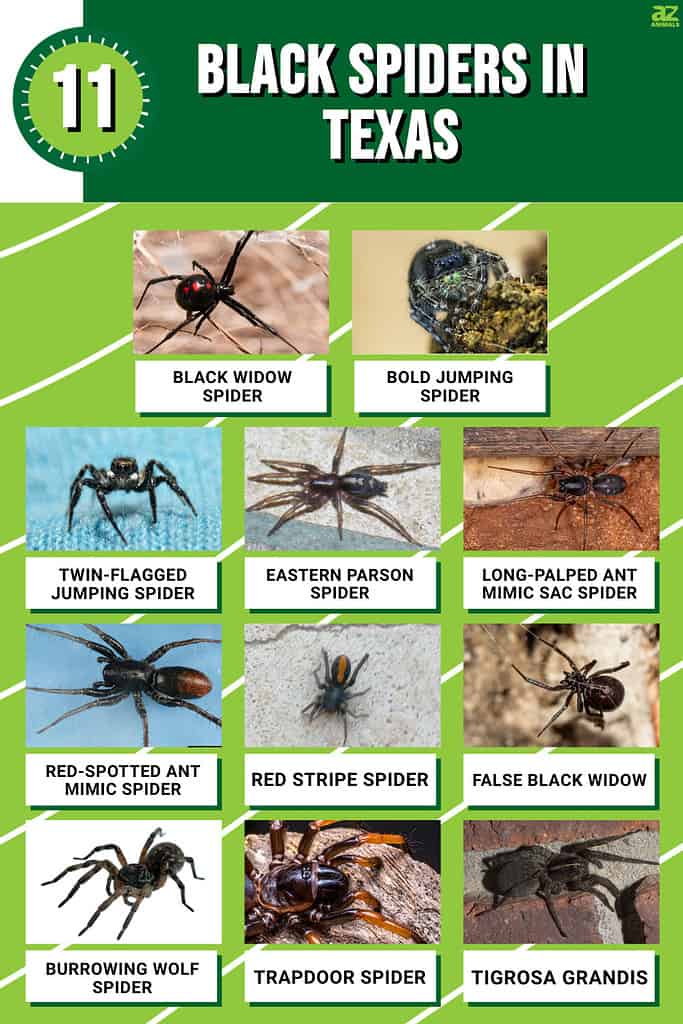
This article lists 11 black spiders in Texas and how to identify them. Read on to learn more detail about these interesting arachnids.
Black Spiders in Texas
1. Black Widow
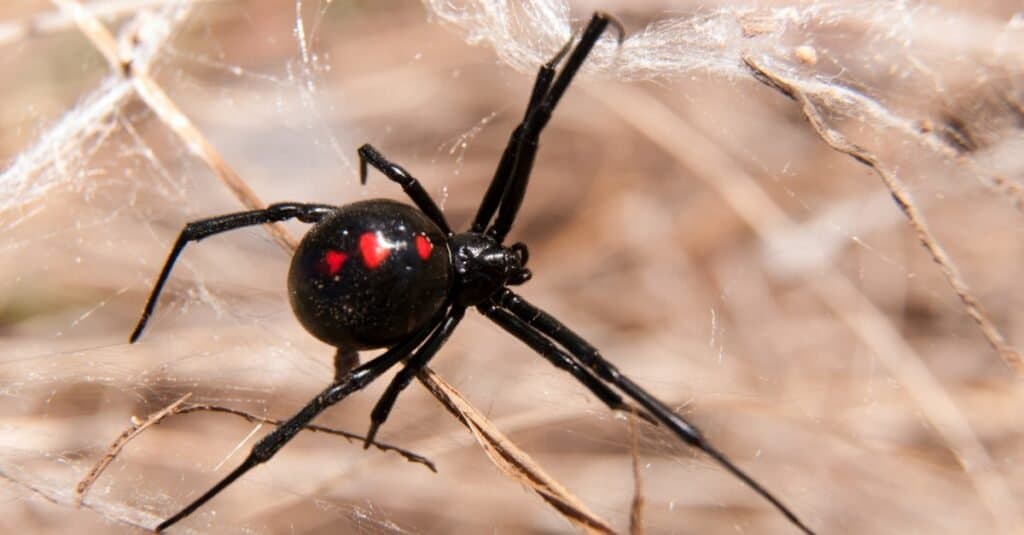
Black widow spiders inhabit vegetation and animal burrows.
©Sari ONeal/Shutterstock.com
The black widow is perhaps the most well-known black spider in Texas as they are also among the most venomous. Although black widow spiders are well-known for their venom, you might not be aware that only the females are dangerous to humans. Perhaps the most well-known of Texas’ hazardous spiders, female black widows have a body coloration of black with distinctive red hourglass markings and can reach a length of one inch. Males only reach a length of 1/4 inch and resemble brown rather than black. Female black widows tend to eat the male after mating, hence their name.
Black widow bites frequently do not initially hurt all that much. However, its venom can cause severe nausea, cramping in the muscles, and even partial paralysis of the diaphragm, making breathing difficult. Serious side effects from black widow bites are uncommon in everyone but extremely young children and very old persons are vulnerable.
Black widows prefer exterior structures like sheds and abandoned wood or trash heaps and inhabit vegetation and animal burrows. Black widows are mostly attracted to environments with insects to hunt and a good spot for their webs.
2. Bold Jumping Spider

The daring jumping spider possesses excellent eyesight and leaping abilities that it uses to catch its prey.
©Mircea Costina/Shutterstock.com
The bold jumping spider‘s scientific name is Phidippus audax. Daring jumping spider is another one of its frequent names. On their abdomen and legs, which are normally black, they have a notable pattern of spots and stripes.
Their front-facing eyes and green metallic mouthparts are their most recognizable features. Even though it is uncommon, this kind of jumping spider can bite when threatened, resulting in minor side effects, including redness, swelling, and itching that last a few days. This spider frequently inhabits garden areas, fences, and external walls. Bold jumping spiders are also frequent in broad fields, grasslands, and gardens. To hunt for prey, they require flat, vertical surfaces. In Texas, jumping spiders are among the most prevalent garden spiders.
3. Twin-Flagged Jumping Spider
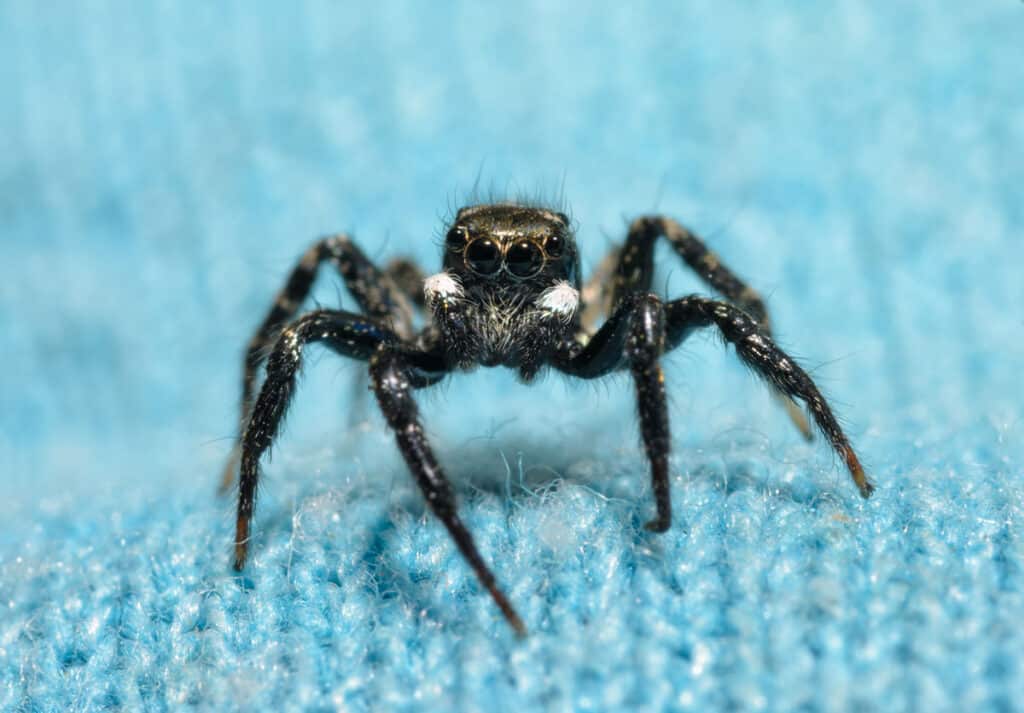
The twin-flagged jumping spider gets its name from the 2 pennant-shaped markings on its cephalothorax.
©Sari ONeal/Shutterstock.com
Because of its two pennant-shaped patterns on the dorsal side of the cephalothorax, the Anasaitis Canosa is more frequently referred to as the twin-flagged jumping spider. The facade of the twin-flagged jumping spider appears to have fifty pairs of legs and they have two to four white marks on the top of their black heads. This tiny leaping spider is frequently observed on top of leaves or artificial constructions like fences and outside walls. The abdomen has a white dash in the middle, and a sizable white ring with some faint chevrons surrounds the dash. They are not harmful, and they will jump to get away. They may be small spiders, but they are quite fast.
4. Eastern Parson Spider

The eastern parson spider features a marking that looks like an 18th-century parson’s necktie.
©Fyn Kynd from Searsmont, Maine, United States / CC BY 2.0, via Wikimedia Commons – License
The parson spider is mostly a black-colored, medium-sized spider. It bears a white stripe on its abdomen that mimics an eighteenth-century necktie with ruffles. The ruffled neck tie marking on the back of the parson spider is what makes it distinctive. It is hairy and ranges in color from light to dark brown.
This nocturnal spider is swift and loves to scurry along walls and the ground in search of its victim. It conceals itself beneath boulders and other debris during the day. Most bites from this spider happen at night or when individuals are hidden under garments, and severe allergic responses rarely happen. They are swift spiders that prowl the ground and walls at night in quest of prey.
5. Long-Palped Ant Mimic Sac Spider
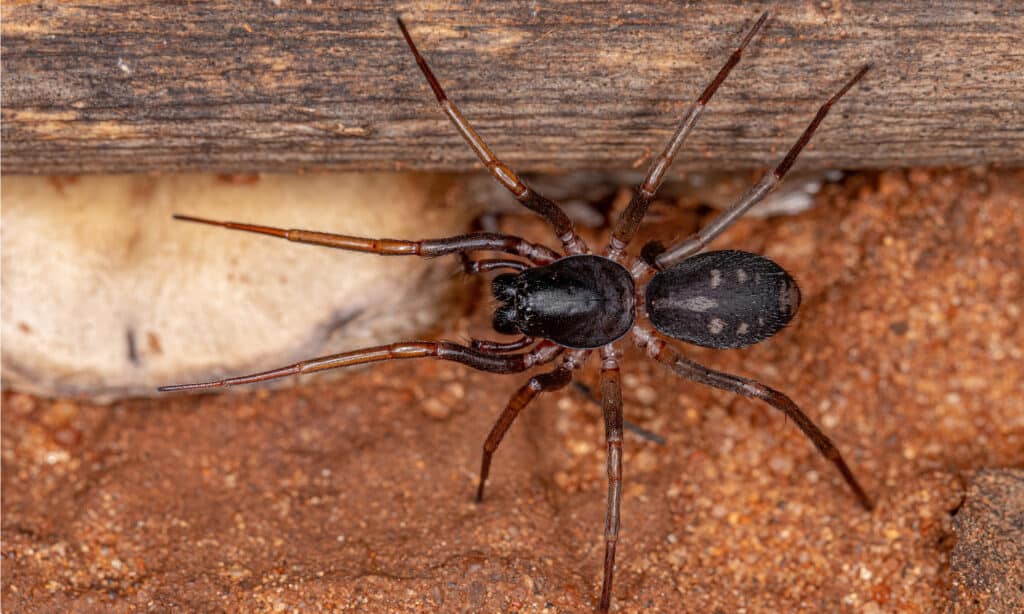
The long-palped ant mimic sac spider can be spotted in the Pacific Northwest and the Eastern United States.
©Vinicius R. Souza/Shutterstock.com
The long-palped ant mimic sac spider does not resemble an ant at all, despite its name. However, every species of the genus ant-mimicking spider moves and acts like ants. It frequently seems to be a six-legged ant with antennae by keeping its two front legs up, just like its near relative, the red-spotted ant mimic spider. In juveniles, the legs are entirely transparent brown. The two front leg pairs of adults often have black at the start and brown near the finish, close to the body.
The long-palped ant mimic sac spider (Castianeira longipalpa) are also present in the Pacific Northwest and the Eastern United States. Bites from this spider are generally rare and as it is small a bite may not pierce the skin — and if it does, the pain will be as much as a bee sting.
6. Red-Spotted Ant Mimic Spider
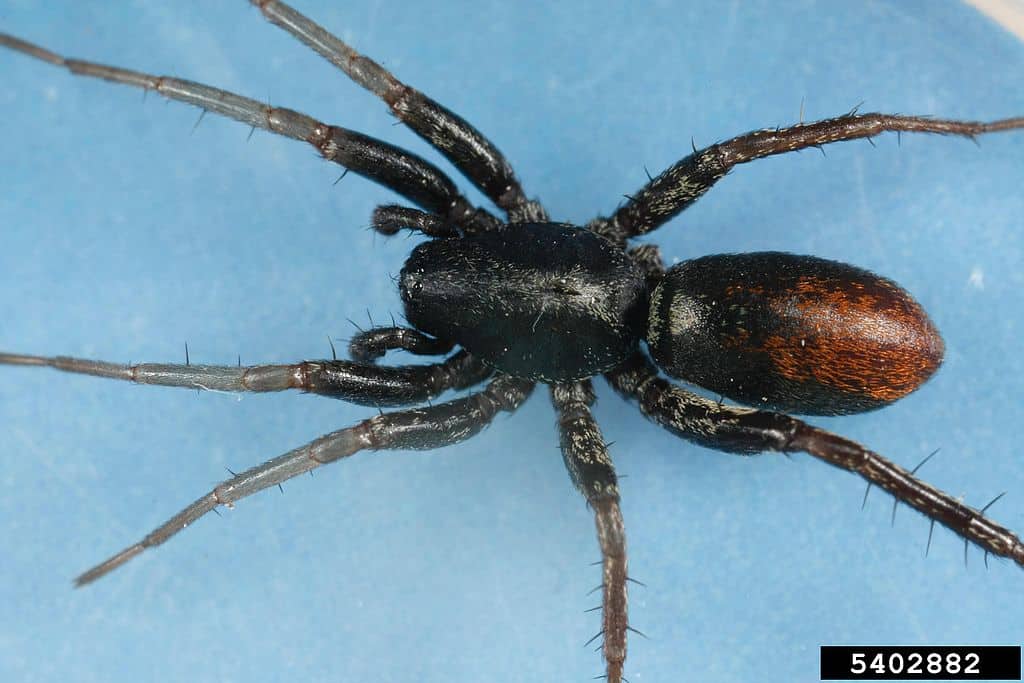
The red-spotted ant mimic spider acts like an ant in order to sneak up on its prey.
©Joseph Berger, Bugwood.org; University of Georgia / CC BY 3.0, via Wikimedia Commons – License
The red-spotted ant mimic spider gets its name from its resemblance with ants, which includes walking on six legs and using the front pair of legs as antennae. These are black spiders and the only additional colors on this arachnid are a huge, brilliant red mark on the abdomen and a white line running down the middle of the carapace. It raises the front two as if they are antennae and walks on its six back legs. This cunning approach calms other ants and insects, making them believe that the spider is not a threat. They are more inclined to let the spider approach, which makes it easy for the spider to devour and kill them.
7. Red Stripe Spider
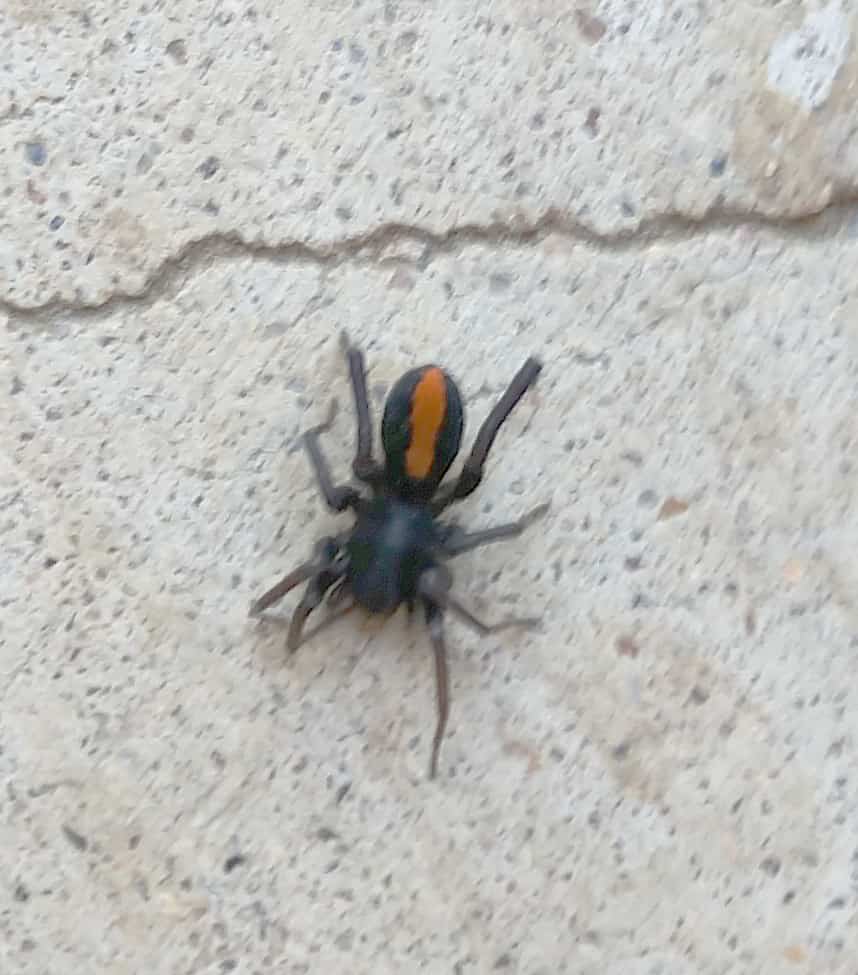
The Red Stripe Spider lives in only two other states besides Texas.
©CowOFacts – Own work / – License
True spider Castianeira crocata, commonly known as the red stripe spider, is a member of the Corinnidae family. Despite having a very different body form, it runs the risk of being mistaken for a black widow spider due to its distinctive black body and red markings on the back. Castianeira crocata’s geographic range, according to data gathered, comprises three states in the United States, including Texas.
8. False Black Widow
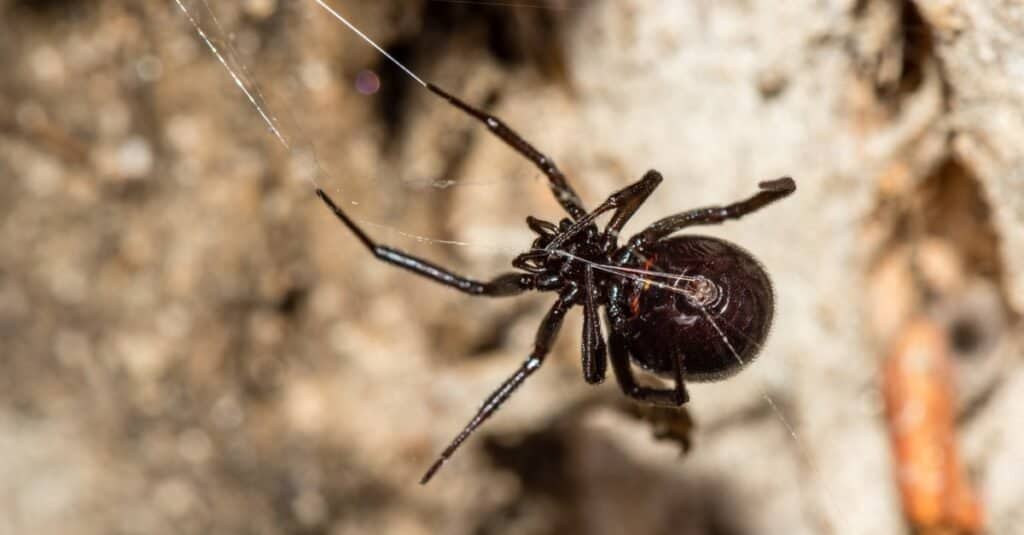
The false widow is less dangerous than the black widow spider.
©Danie Spreeth Photography/Shutterstock.com
False widows, which have dark, rounded bodies and are sometimes mistaken for black widows, are devoid of an hourglass-shaped marking or any other form of brilliant, distinguishing feature. They are present in all human populations. False black widow spiders can still cause very painful bites, although they are less dangerous to humans than black widows.
This species will only bite humans if they are in grave danger. Although their bites might result in symptoms like fever, perspiration, and muscle spasms, they normally don’t need to be treated immediately.
False black widow spiders typically inhabit fences, walls, and tree bark. These spiders are also frequently seen in and around homes, gardens, and under rocks and wood. They rely primarily on vibrations getting near them through their webs to locate prey or alert themselves of danger, such as larger animals that could kill them.
9. Burrowing Wolf Spider
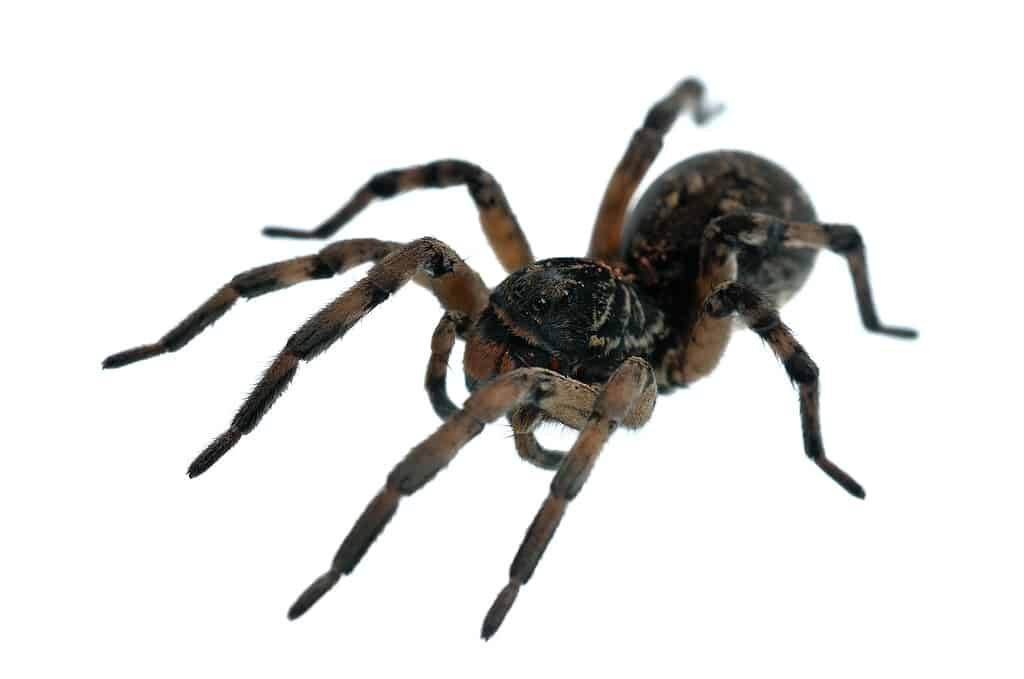
The large, fast-moving burrowing wolf spider digs vertical tunnels for a refuge.
©D. Kucharski K. Kucharska/Shutterstock.com
To survive their whole lives—or, in the case of males, until they reach sexual maturity and leave their burrows in search of mates—burrowing wolf spiders dig vertical tunnels. Numerous wolf spider species dig underground caverns that they use as refuges at different stages of their lives. Some members of the family—mostly those belonging to the genus Geolycosa—are obligate burrowers who dig roughly vertical tunnels up to 15 to 30 body lengths deep. Their bodies frequently have black, gray, and brown patterns. These wolf spiders are swiftly moving and fairly enormous.
10. Trapdoor Spider
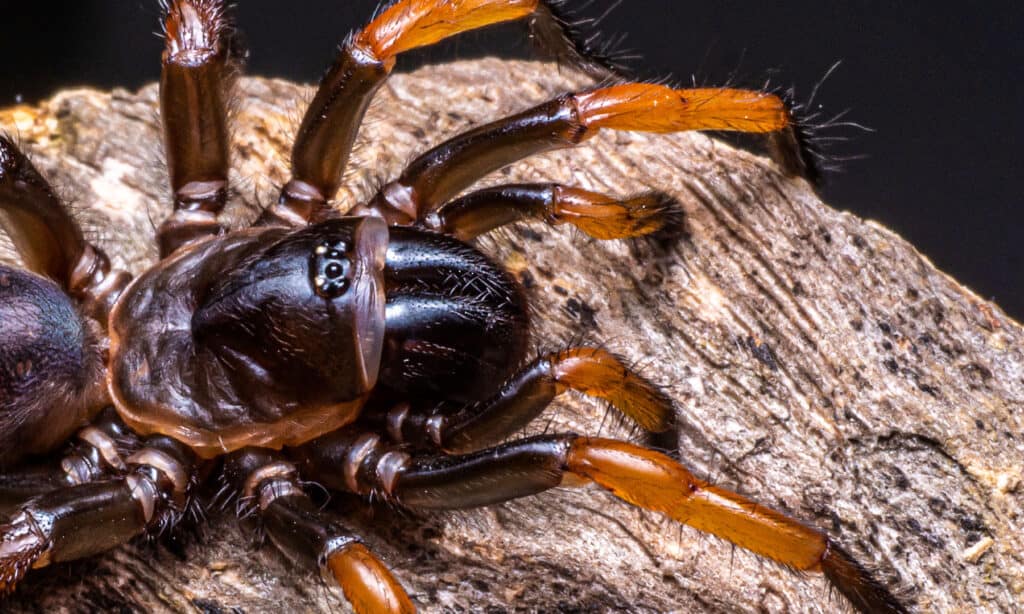
Trapdoor spiders have smooth bodies and colors ranging from black to dark brown.
©nokkaew/Shutterstock.com
Although trapdoor spiders are not the largest in Texas, they can reach respectable sizes. They can reach lengths of 1 and 14 inches and are 2.5 inches wide. They have smooth bodies and colors ranging from black to dark brown. These spiders retreat inside their tunnels when they feel threatened. The symptoms of bites, which are uncommon, go beyond little pain. Unmidia, also known as trapdoor spiders, is a genus that can be found worldwide but is most prevalent in North America.
11. Tigrosa Grandis
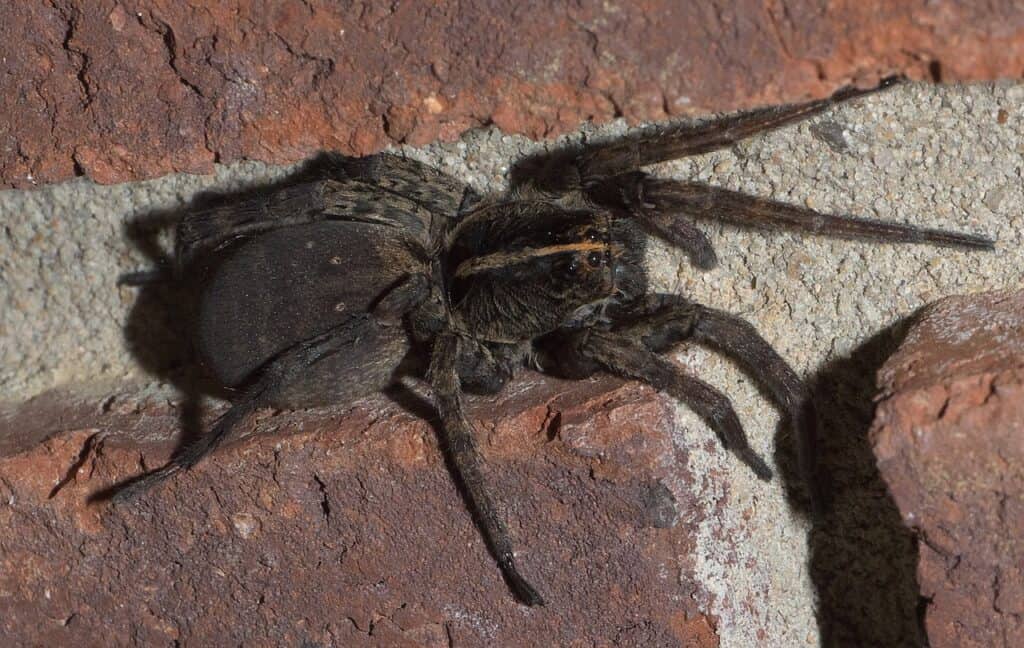
Tigrosa grandis can be found from Montana down to Texas.
©xpda / CC BY-SA 4.0 – License
A type of wolf spider (Lycosidae) known as Tigrosa grandis is only found in the United States, where it may be found from Montana down to Texas. According to data gathered, the Tigrosa grandis’ geographic range comprises 5 states in the United States, including Texas. The month of August is the one in which Tigrosa grandis is most frequently spotted outside.
Summary of 11 Black Spiders in Texas
| Number | Spider |
|---|---|
| 1 | Black Widow |
| 2 | Bold Jumping Spider |
| 3 | Twin-Flagged Jumping Spider |
| 4 | Eastern Parson Spider |
| 5 | Long-Palped Ant Mimic Sac Spider |
| 6 | Red-Spotted Ant Mimic Spider |
| 7 | Red Stripe Spider |
| 8 | False Black Widow |
| 9 | Burrowing Wolf Spider |
| 10 | Trapdoor Spider |
| 11 | Tigrosa Grandis |
The photo featured at the top of this post is © Jay Ondreicka/Shutterstock.com
Sources
- Bird Watching Hq, Available here: https://birdwatchinghq.com/common-spiders-in-texas/
- Texas A&M AgriLife Extension, Available here: http://texashighplainsinsects.net/spiders
- ThePetEnthusiast, Available here: https://thepetenthusiast.com/spiders-in-texas/
Thank you for reading! Have some feedback for us? Contact the AZ Animals editorial team.






